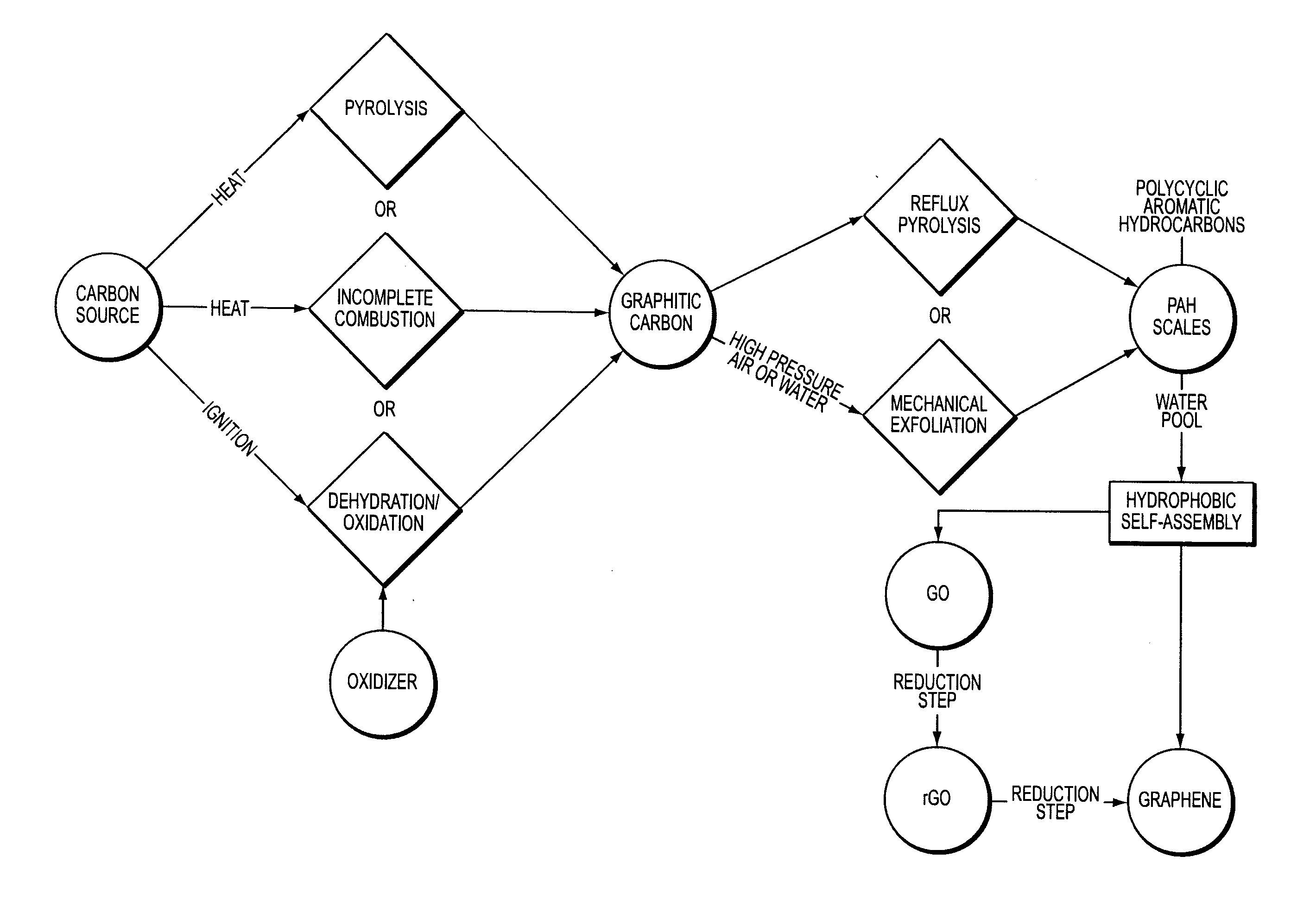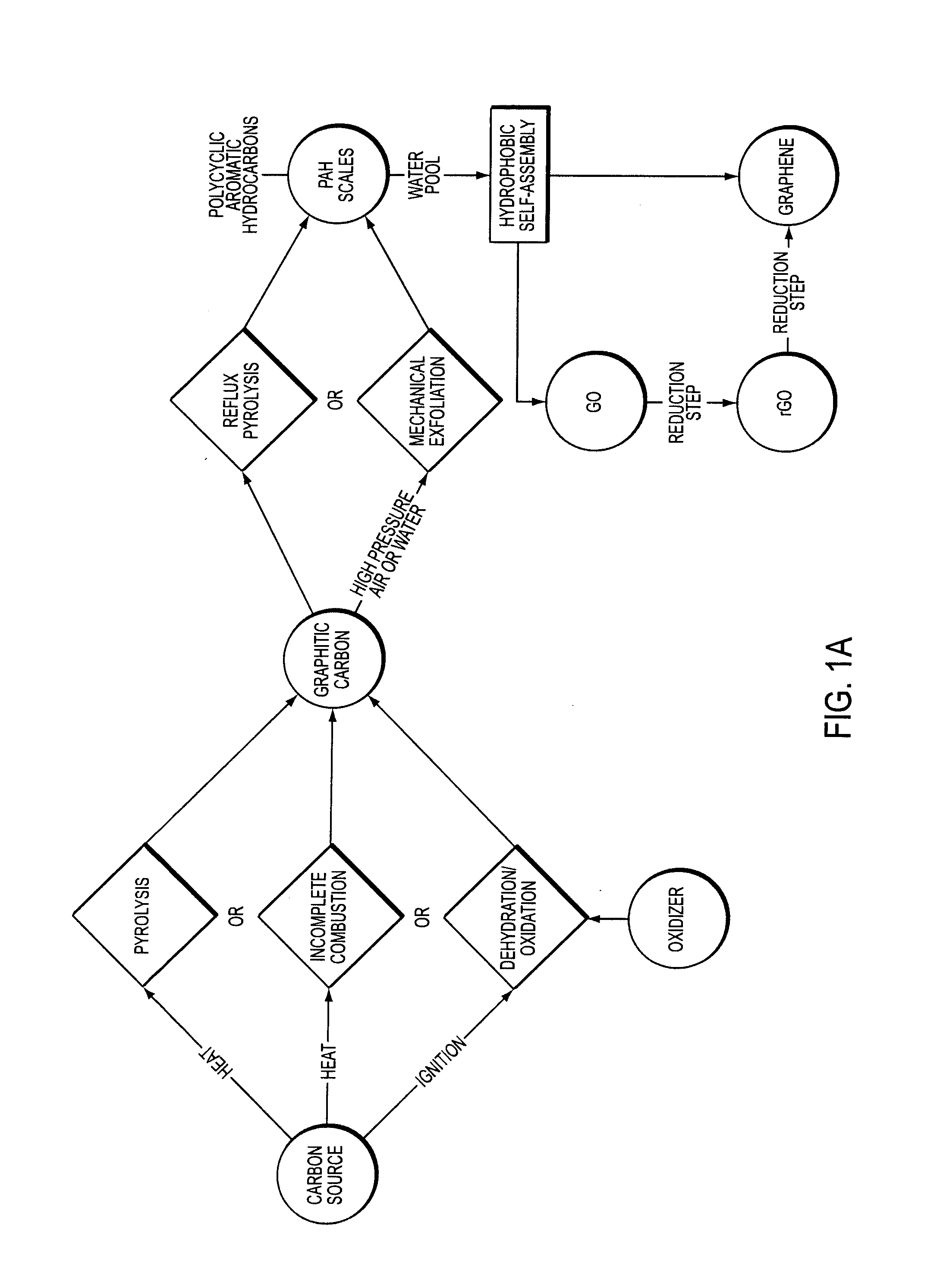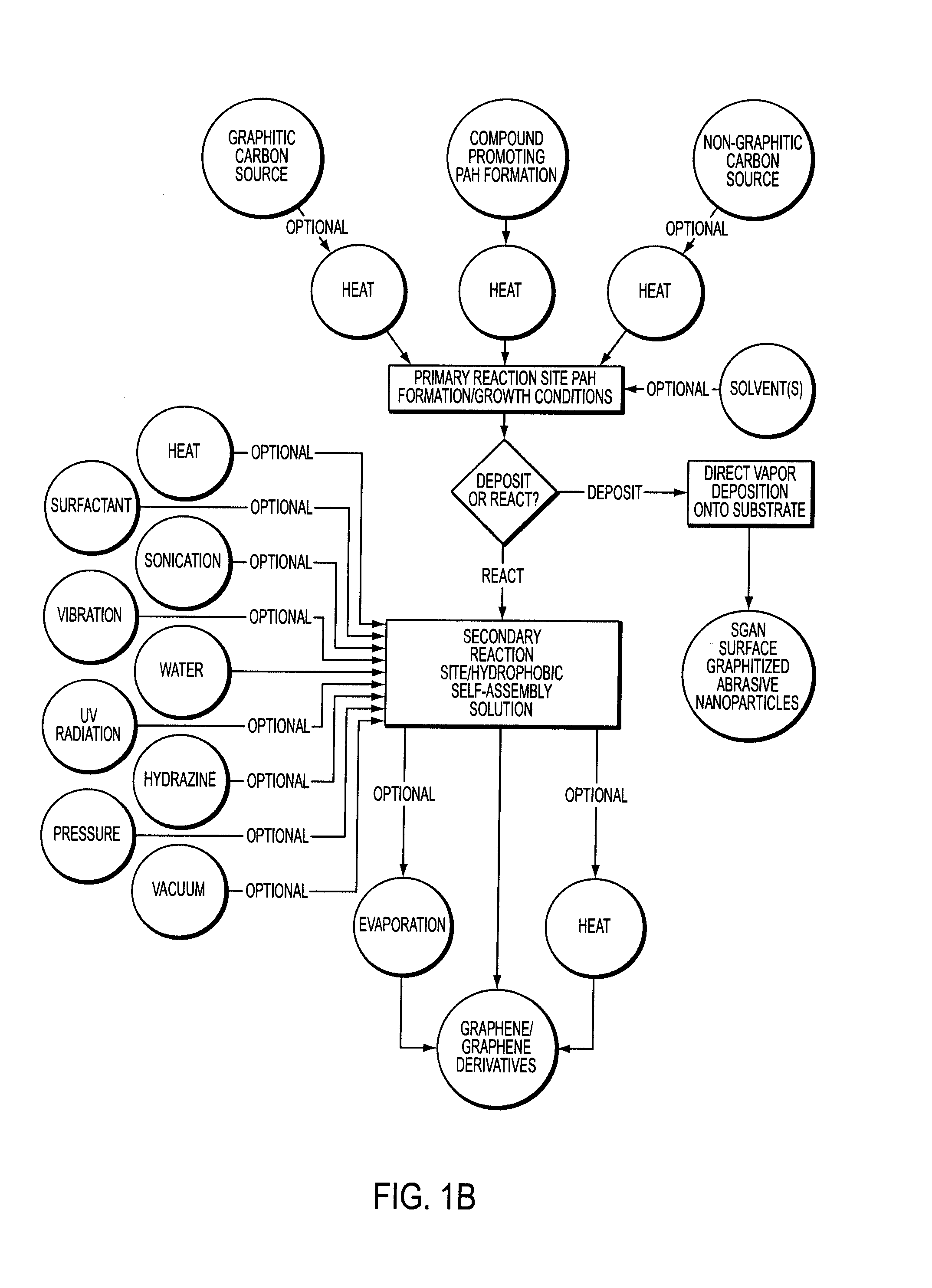Facile synthesis of graphene, graphene derivatives and abrasive nanoparticles and their various uses, including as tribologically-beneficial lubricant additives
a technology of graphene derivatives and abrasives, which is applied in the field of graphene derivatives and abrasive nanoparticles and their various uses, to achieve the effects of improving the inherent physical lubricating properties, reducing the friction between the wear surface, and high smoothness
Active Publication Date: 2014-05-15
PEERLESS WORLDWIDE
View PDF0 Cites 64 Cited by
- Summary
- Abstract
- Description
- Claims
- Application Information
AI Technical Summary
Benefits of technology
[0080]In one embodiment, the resulting graphene sheets may be used to produce a range of useful products, including, but not limited to, low-weight, high-strength, graphene-reinforced composites.
[0081]In one embodiment, suitable additives to conventional lubricants promote the in situ formation of tribologically-useful graphitic carbon-containing nanoparticles or microparticles in tribologically-effective amounts. In one embodiment, the additive comprises a chemical structure having at least one carbon ring. In one embodiment, the nanoparticles are abrasive nanoparticles that act as nano-polishing agents to nano-polish friction surfaces to a high smoothness by reduction or removal of asperities, thereby reducing the friction between the wear surfaces. In one embodiment, the additive to the lubricant comprises a form of graphitic carbon which is formed ex situ prior to addition to the lubricant to form a lubricating composition.
[0082]In one embodiment, the additive to the lubricant comprises an iron complex molecule. In one embodiment, the additive comprises nanoparticles of carbon-containing particulate matter. In one embodiment, the additive is dissolved in the lubricant to form the lubricating composition. In one embodiment, the additive is miscible with the lubricant to form the lubricating composition. In one embodiment, a carbon-containing precursor molecule in the form of one or more sugar or sugar-like amphiphiles, is employed to
Problems solved by technology
Large-scale and economical production methods have, however, remained elusive.
1058-1063, 2009), yet the exact chemical structure of GO is still the subject of much debate and considerable variability, at least in terms of hydroxyl and epoxide group frequency and location observed in the various samples studied.
As graphene oxide has its own unique physical and chemical characteristics apart from graphene, its structural variability has made it less attractive for many experimental studies.
3343-3364, 2010), yet the beneficial use of such sequestered or captured carbon wastes as carbonaceous feedstock or promoters in the synthesis of graphene remains unreported.
Synthesis of steel-reinforced nanoparticles, nano-onions, and methods of producing neat nano-steel crystals and nanoscopic metal sheets, however, remain unreported.
In the case of polymer matrix composite (PMC) ballistic panels, the fibers' force-dispersing deformation ability is severely hampered by the surrounding resin of the composite, which leads to failure under conditions of fracture and delamination of the resin matrix upon impact from a projectile.
Friction in any system is the cause of stress, fatigue, wear, heat, noise, vibration, and eventually failure.
The other common enemy of the aforementioned metal-containing mechanical systems is corrosion.
Interaction of these uneven surface asperities increases friction.
Marked reduction in friction through so-called “super-polishing” of components to high tolerances (Ra<50 nm) to date has meant substantial additional production time and costs.
None of these methods affect the so-called Ra (Roughness Average) values of the interacting metallic component surfaces and do nothing to ameliorate the friction-causing effects of the asperities themselves.
Some lubricant additives that have been developed to reduce friction include the following: triorthocresyl phosphate (TOCP, or simply TCP), popular in aviation lubricants but known to slowly attack elastomer gaskets and seals; naphthenic hydrocarbon detergents, known to combine with the products of incomplete combustion to form hydrochloric acid; zinc dialkydithiophosphates (ZDDPs), problematic to vehicles equipped with catalytic converters; chlorinated paraffins, identified globally as extremely harmful to aquatic life; suspended solids such as polytetrafluoroethylene (PTFE, trade name Teflon®), considered undesirable for lubrication by many; graphite powder, considered by many to be undesirable in systems employing bearings; molybdenum, a metal reported to reduce fuel economy; tungsten
Method used
the structure of the environmentally friendly knitted fabric provided by the present invention; figure 2 Flow chart of the yarn wrapping machine for environmentally friendly knitted fabrics and storage devices; image 3 Is the parameter map of the yarn covering machine
View moreImage
Smart Image Click on the blue labels to locate them in the text.
Smart ImageViewing Examples
Examples
Experimental program
Comparison scheme
Effect test
 Login to View More
Login to View More PUM
| Property | Measurement | Unit |
|---|---|---|
| Electric charge | aaaaa | aaaaa |
| Hydrophilicity | aaaaa | aaaaa |
Login to View More
Abstract
Methods of ex situ synthesis of graphene, graphene oxide, reduced graphene oxide, other graphene derivative structures and nanoparticles useful as polishing agents are disclosed. Compositions and methods for polishing, hardening, protecting, adding longevity to, and lubricating moving and stationary parts in devices and systems, including, but not limited to, engines, turbos, turbines, tracks, races, wheels, bearings, gear systems, armor, heat shields, and other physical and mechanical systems employing machined interacting hard surfaces through the use of nano-polishing agents formed in situ from lubricating compositions and, in some cases, ex situ and their various uses are also disclosed.
Description
REFERENCE TO RELATED APPLICATIONS[0001]This application claims the benefit of U.S. Provisional Patent Application No. 61 / 596,936, filed Feb. 9, 2012 and titled Tribologically Beneficial Carbonaceous Materials and Nano-Abrasive Lubricant Molecules From Intentional In-Situ Pyrolysis of Sacrificial Cyclic Carbon Constituents; U.S. Provisional Patent Application No. 61 / 579,993, filed Dec. 23, 2011 and titled Graphene and Graphene Derivatives Synthesis By Dehydration or Pyrolysis of Carbonaceous Materials, Vapor Exfoliation or PAH Formation, and Subsequent Hydrophobic Self-Assembly; U.S. Provisional Patent Application No. 61 / 568,957, filed Dec. 9, 2011 and titled Synthesis of Graphene, Graphene Derivatives, Carbon-Encapsulated Metallic Nanoparticles, and Nano-Steel, and the Use of Sequestered Carbonaceous Wastes and Greenhouse Gases in Such Synthesis Methods; U.S. Provisional Patent Application No. 61 / 546,368, filed Oct. 12, 2011 and titled Combustion Synthesis of Graphene Oxide and Grap...
Claims
the structure of the environmentally friendly knitted fabric provided by the present invention; figure 2 Flow chart of the yarn wrapping machine for environmentally friendly knitted fabrics and storage devices; image 3 Is the parameter map of the yarn covering machine
Login to View More Application Information
Patent Timeline
 Login to View More
Login to View More IPC IPC(8): C01B31/04
CPCC01B31/043C01B31/0446B82Y30/00B82Y40/00F16D2300/06F16D2300/10C10M177/00C10M103/02C10M2201/0413A61K8/0241A61K8/19A61K2800/28A61K2800/413C01B32/225C01B32/23C01B32/184C01B32/186C22C33/00C22C33/006C22C38/00Y10S977/734C01B32/192A61K2800/10A61Q17/04A61Q19/00Y10S977/843Y10S977/902Y10S977/755C01B32/205C01B32/21C10N2030/06C01B32/198B82B3/00C01B32/194B82B3/0009C10M125/02C10N2020/06C10M125/04C10M129/70B01J13/0056C10M171/06C10M2201/041
Inventor SHANKMAN, RICHARD S.
Owner PEERLESS WORLDWIDE
Features
- R&D
- Intellectual Property
- Life Sciences
- Materials
- Tech Scout
Why Patsnap Eureka
- Unparalleled Data Quality
- Higher Quality Content
- 60% Fewer Hallucinations
Social media
Patsnap Eureka Blog
Learn More Browse by: Latest US Patents, China's latest patents, Technical Efficacy Thesaurus, Application Domain, Technology Topic, Popular Technical Reports.
© 2025 PatSnap. All rights reserved.Legal|Privacy policy|Modern Slavery Act Transparency Statement|Sitemap|About US| Contact US: help@patsnap.com



